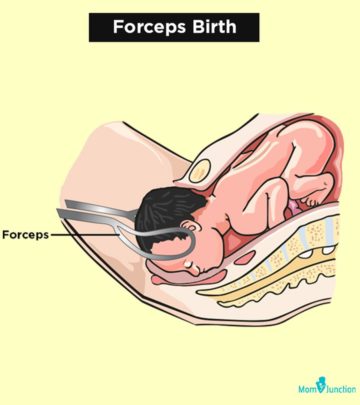
Forceps delivery is an assisted delivery method in which the doctor uses forceps to hold the baby’s head and aid the baby to come out of the birth canal. This method is used during vaginal deliveries when the baby is in the head-first position in the birth canal but the mother finds it difficult to push the baby out. Although this method is extremely useful to ease difficult labor, it has certain risks that need careful assessment.
Read this post to know more about forceps delivery, including when its use becomes necessary, its advantages and disadvantages, and tips to prevent a forceps delivery.
What Is Forceps Delivery?
Forceps delivery is an instrumental vaginal delivery used when the labor progresses slowly. A forceps is a medical tool resembling the stainless steel salad tongs. It holds the head of the baby gently and aids in smooth passage out of the birthing canal. Doctors choose this assisted delivery method when the baby needs to be delivered quickly and safely.
When Will Forceps Be Used?
A forceps delivery is carried out if (1):
- The mother gets exhausted during the second stage of labor.
- Prolonged labor and exhaustion that decreases mother’s desire to push.
- Fetal distress is suspected.
- Use of rotational instrumental delivery is necessary, in the case of a malpositioned fetus.
A forceps delivery becomes more critical than vacuum extraction method or a c-section in the following situations:
- Assisted delivery of the preterm infant (
- Delivery of the head at assisted breech delivery (singleton or twin)
- Assisted delivery with a face presentation
- Controlled delivery of head at cesarean section
- Instrumental delivery for maternal medical conditions that preclude pushing
- Assisted delivery with suspected coagulopathy or thrombocytopenia in the fetus
- Cord prolapse in the second stage of labor
- Instrumental delivery under general anesthesia
However, forceps delivery is not ideal if (2),
- The position of the baby’s head is not determined accurately.
- Baby’s head has not moved far in the birthing canal.
- A physical condition of the baby affecting the bone strength or causing a bleeding disorder.
- Size of the baby is large and not fitting into the pelvis.
Keep reading to know what exactly happens during a forceps delivery.
What Happens During A Forceps Delivery?
Before the forceps delivery, the doctor will do preliminary pelvic examinations. They will check for:
- Baby’s position
- Cervical dilation
During the procedure:
- A thin catheter is passed through your urethra to empty your bladder.
- The doctor then gives a pain relief injection to numb the vagina (if an epidural or a pudendal block were not administered earlier). The heartbeat of the baby will be closely monitored throughout the procedure.
- The doctor will then do an episiotomy to open up the vagina.
- The forceps will be applied gently one at a time to each side of the baby’s head.
- As you feel the contraction, the doctor will slowly guide the baby out with forceps, as the mother pushes.
- If the baby is not facing downwards, then the doctor might rotate the baby using the forceps.
Note: If the baby is not moving even after three contractions or pulls using forceps, then the doctor may recommend a c-section.
After the procedure:
The doctor will check for any injuries and the baby will be monitored for any complications due to this method of assisted delivery.
The patient may experience discomfort or pain for a few weeks after the forceps delivery. But if the pain is intense and does not subside, make sure to visit your doctor.
What Are The Different Types Of Forceps Used?
There are more than 700 types of forceps developed for this assisted delivery method. The commonly used forceps are (3):
- Simpson forceps, which are elongated with a cephalic curve, is used when the baby’s head attains a cone-like shape while it comes through the vagina.
- Elliot forceps are rounded with a cephalic curve and used when the head of the baby is round in shape.
- Kielland forceps have a shallow pelvic curve shape with a sliding lock. They are used to rotate the baby.
- Wrigley’s forceps consist of short stems and blades, which can reduce the chances of any complications such as uterine rupture. It is mainly useful when the baby is far inside the birthing canal.
- Piper’s forceps are made of downward-curving stems, which can easily fit around the baby’s body and allows the doctor to get a grip on the baby’s head during a breech delivery.
Using the right type of forceps in the right manner is imperative to avoid the risks of this assisted delivery technique.
What Are The Risks Of Forceps Delivery?
Possible risks of forceps delivery in women include (2):
- Perineum pain (perineum is the skin between the vagina and the anus)
- Third-degree tears in the lower genital tract
- Urination difficulties
- Urinary or fecal incontinence
- Anemia, due to blood loss
- Injuries to the urethra or bladder
- Tearing of the uterine wall
- The weakening of the pelvic ligaments and muscles.
Possible risks of forceps delivery in babies are:
- Minor facial injuries due to forceps pressure
- Facial palsy
- External eye injuries
- Skull fracture with internal bleeding
- Seizures
- Marks of forceps on the baby’s face, which disappears within 48 hours (4).
- Increased risk of Vitamin K Deficiency Bleeding (VKDB), which is a rare and serious disease associated with intracranial bleeding (5).
- The large bruises caused by the use of forceps may get reabsorbed and make the old blood break down to make more bilirubin. Excess bilirubin in the bloodstream can give rise to jaundice if the infant’s liver does not clear away the excess bile in time (6).
Read on to learn more about the disadvantages of this delivery method and determine whether or not it is for you.
What Are The Advantages And Disadvantages Of Forceps Delivery?
Following are the advantages and disadvantages of forceps delivery.
In comparison to vacuum extraction:
| Advantages | Disadvantages |
|---|---|
| Less failure rate | Stronger maternal analgesia needed |
| Quicker delivery in case of fetal distress | Greater maternal perineal trauma |
| Reduced need for constant use of instruments | Facial bruising and Facial nerve palsy in babies. |
| Fewer cases of retinal hemorrhage and cephalohematoma | Skull fracture |
In comparison to C-section:
| Advantages | Disadvantages |
|---|---|
| Major obstetric hemorrhage and admission to NICU are rare | Trauma to the baby |
| Shorter hospital stay and fewer readmissions | Perineal trauma in the mother |
| Chances of subsequent vaginal delivery are more | Urinary incontinence and dyspareunia are more common |
Forceps delivery also results in an episiotomy, a surgical cut that needs time and care to heal after the delivery.
Healing Of Episiotomy After Forceps Delivery
Here are some tips to follow, to soothe the episiotomy wound:
- Use ice-packs or a chilled witch hazel pad.
- After urination, use warm water to clean the area.
- During the bowel movement, keep a clean pad firmly against the wound.
- Avoid sitting on a hard surface. Instead, use a pillow or a padded ring while sitting.
- Lavender essential oil is also useful in treating episiotomy wounds (7).
Once the wound starts to heal, you can begin Kegel exercises that can help strengthen the pelvic floor muscles. In case of constipation, eat fiber-rich food to ease the bowel movements. Following a healthy diet and lifestyle can also help you deliver the child smoothly, without assistance or intervention.
How To Prevent A Forceps Delivery?
Labor can begin anytime, and there is no way to predict if you’d be delivering the baby vaginally or through a c-section. But you can increase the odds of a normal, smooth delivery by following a healthy lifestyle and diet. You can prevent a forceps delivery by following some simple tips:
- Eat healthy food.
- Engage in regular and moderate exercises.
- Enroll in childbirth classes to learn about labor.
Frequently Asked Questions
1. Can I refuse forceps delivery?
The type of delivery is your personal preference. However, certain circumstances, such as the risk of pushing in natural delivery, a breech baby, or a baby in distress may prompt the doctors to conduct a forceps delivery. It is completely safe, so try to discuss the procedure and weigh the pros and cons with your Ob/Gyn before refusing it (4).
2. How common is forceps delivery?
According to a cohort study, forceps deliveries make up about 1.1% of vaginal deliveries (8). You may not worry as the medical procedure is safe and done by experienced doctors.
Your doctor may choose forceps delivery when you cannot push during labor or suspected fetal distress. There are different kinds of forceps delivery, and your doctor will decide the best technique based on the baby’s position. This assisted delivery has shorter hospital stays or uses fewer instruments. However, your doctor can only use this method to ease difficult labor and make the delivery smooth. Following some simple tips, such as regular exercises and enrolling in childbirth classes, might help you avoid this kind of assisted delivery.
References
1. R. R. Patel, D. J. Murphy; Forceps delivery in modern obstetric practice; NCBI (2004)
2. J. Y. Lo; What moms should know about forcep and vacuum deliveries; The University of Texas Southwestern Medical Center
3. D. M. El-Mowafi; Forceps Delivery; Geneva Foundation for Medical Education and Research
4. Forceps or vacuum delivery; NHS
5. Vitamin K: Injection or oral dose for newborns; NCT
6. D. L. Preud’Homme; Neonatal Jaundice; American College of Gastroenterology(2006)
7. Lavender Essential Oil and Povidone-iodine Are Similarly Effective Treatments for Episiotomy Wound Healing; American Botanical Council (2011)
8. Engelbert P. Bonilla and John Riggs; Forceps Delivery; NCBI
















